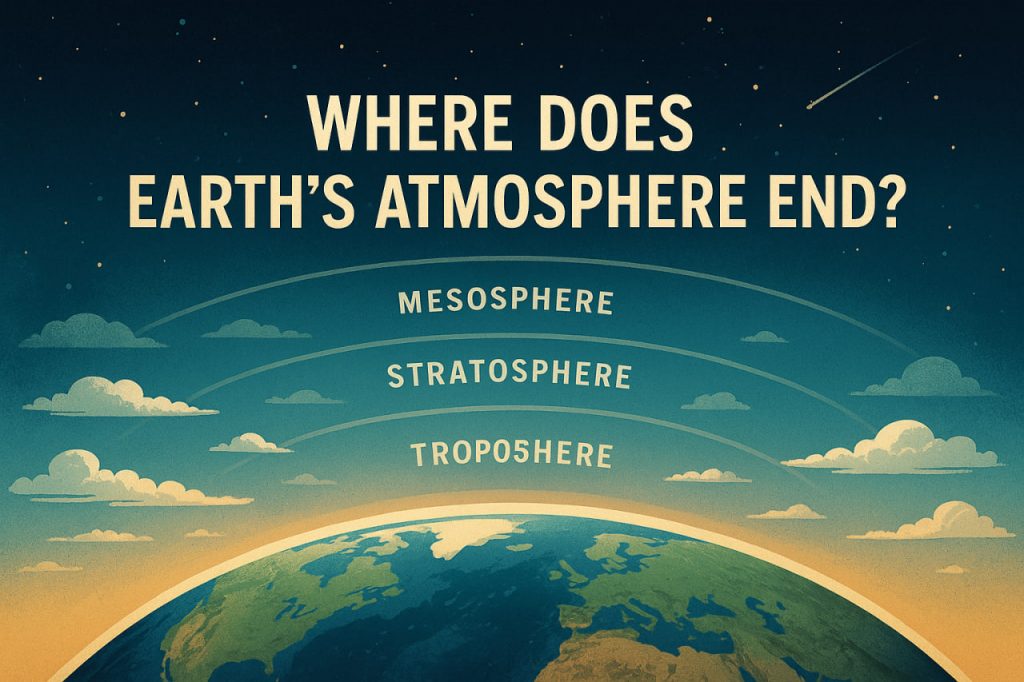The atmosphere of Earth is a vast and complex layer of gases that surrounds the planet, gradually thinning with altitude. But where does it actually end? Unlike a solid surface, the boundary of Earth’s atmosphere isn’t sharply defined. Instead, it fades into the vacuum of space over hundreds of kilometers. Scientists have proposed several definitions for the “edge” of the atmosphere, depending on whether they’re discussing physics, satellite motion, or legal boundaries.
Understanding where the atmosphere ends helps us define space travel, satellite orbits, and the Earth’s interaction with space weather and solar radiation.
Layers of the Atmosphere
Earth’s atmosphere is divided into five main layers based on temperature gradients:
- Troposphere (0–12 km): The lowest layer, where weather occurs and where most of the air mass is located.
- Stratosphere (12–50 km): Home to the ozone layer, protecting life from harmful UV radiation.
- Mesosphere (50–85 km): The coldest layer, where meteors burn up.
- Thermosphere (85–600 km): Contains ionized particles and the auroras. Temperature can reach thousands of degrees, but it feels cold due to low density.
- Exosphere (600–10,000 km): The outermost layer, where atmospheric gases escape into space. This is a transition zone rather than a strict boundary.
The Kármán Line
One of the most commonly cited boundaries of space is the Kármán line, located at 100 kilometers (62 miles) above sea level. Proposed by physicist Theodore von Kármán, this altitude marks the point where a conventional aircraft would need to travel faster than orbital velocity to generate sufficient lift.
Many space agencies and treaties recognize this as the official boundary of outer space, including the Fédération Aéronautique Internationale (FAI).
Alternate Definitions
However, not all institutions agree on the 100 km boundary:
- NASA and the U.S. Air Force often define space as starting at 80 km (50 miles).
- Some studies suggest that the exosphere continues out to 10,000 km, where atmospheric particles finally escape Earth’s gravity.
- The geocorona, a very thin outer layer of hydrogen, extends as far as 630,000 km, according to satellite data, though it is nearly undetectable.
These definitions vary depending on whether we focus on orbital mechanics, aerodynamics, or physical composition.
Why Does It Matter?
Defining the edge of the atmosphere has implications for:
- Legal airspace vs. outer space (important for sovereignty and military applications)
- Space tourism and astronaut status
- Satellite and spacecraft design, since drag from the upper atmosphere can affect orbits
- Modeling of space weather and solar wind interactions with Earth’s magnetic field
Moreover, understanding the upper atmosphere helps us monitor climate change, radiation levels, and communication satellite performance.
Glossary
- Atmosphere – the envelope of gases surrounding Earth
- Kármán line – theoretical boundary of space at 100 km altitude
- Exosphere – outermost layer of the atmosphere where particles escape into space
- Geocorona – extremely thin, outermost hydrogen layer of Earth’s atmosphere
- Space weather – conditions in space affected by the Sun’s activity
- Orbital velocity – the speed required to stay in orbit around Earth


